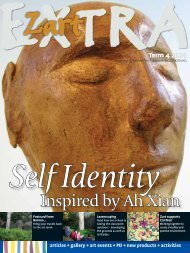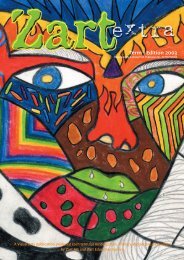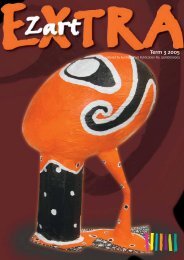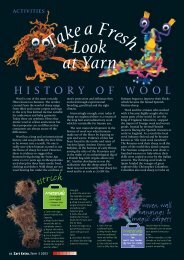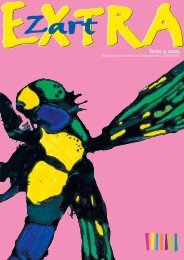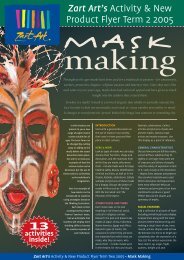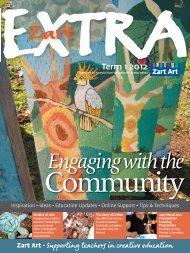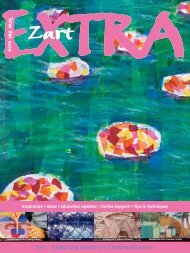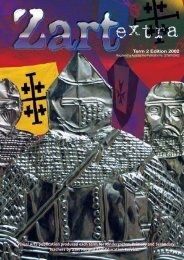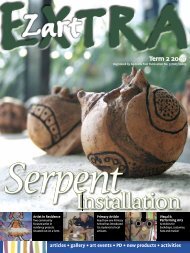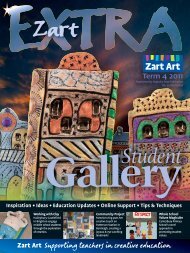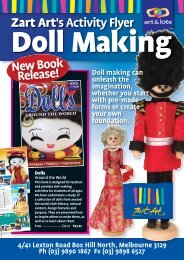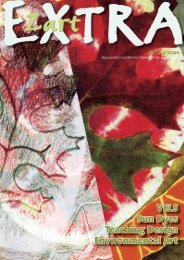Term 3 2007 Plus... Careers In Art - Zart Art
Term 3 2007 Plus... Careers In Art - Zart Art
Term 3 2007 Plus... Careers In Art - Zart Art
You also want an ePaper? Increase the reach of your titles
YUMPU automatically turns print PDFs into web optimized ePapers that Google loves.
careers in art<br />
It has had a great and very<br />
positive effect to be<br />
connected to the World<br />
from where I live and work,<br />
I use computer graphics to<br />
do prints and design cards,<br />
but my paintings still come<br />
from the inner creative part<br />
of me.<br />
What are some of the<br />
negative aspects of your<br />
job<br />
Keeping on top of the<br />
business side. Being my<br />
own worst secretary.<br />
What is something you<br />
would love to do that you<br />
haven’t already done<br />
Stage set for contemporary<br />
opera.<br />
How would you describe<br />
your first solo exhibition<br />
A positive surprise At AM<br />
Sachs Gallery, 57th street in<br />
New York City in 1973. The<br />
art dealer said, “You won’t<br />
sell any work because no<br />
one knows your name”. My<br />
first sale in New York City. A<br />
man walked in off the<br />
street and bought one, just<br />
because he liked it.<br />
Clement Greenberg saw the<br />
show and told the dealer<br />
“This work is very mature<br />
for a young artist”.<br />
Where do you get most of<br />
your inspiration<br />
Looking at and<br />
experiencing nature. I never<br />
want to imitate it, but the<br />
colour and the light have a<br />
lasting effect on my mind,<br />
and it permeates every<br />
brush stroke I make on the<br />
canvas.<br />
What fellow artist has<br />
most influenced you<br />
<strong>In</strong> the past few years. Robert<br />
Irwin, for his absolute<br />
simplicity and its effects of<br />
light and colour in his work.<br />
Lee Krasner for her density<br />
of forms and her wild paint<br />
application. Also for knowing<br />
before anyone else, that her<br />
husband was a brilliant artist.<br />
Brice Marden for being open<br />
to experimentation in the<br />
way he works. It creates<br />
freedom in his paintings. <strong>In</strong><br />
the past: El Greco for the<br />
most beautiful colour that<br />
defines all his forms and<br />
creates very emotional<br />
images. Every time I look at<br />
his paintings I see something<br />
new that he has achieved.<br />
Giotto for being so<br />
contemporary for his time<br />
and his exquisite sense of<br />
colour<br />
What’s your favourite<br />
piece of work to date<br />
I favour them all for<br />
different reasons but there<br />
is one… A painting called<br />
“Clouds in The Mountain”<br />
in the collection of the<br />
Embassy of Australia in<br />
Washington DC. It is one of<br />
my most original works.<br />
What is your favourite<br />
piece of clothing in your<br />
wardrobe<br />
A paisley print, pink and<br />
gold silk skirt purchased<br />
from Banana Republic. I<br />
have been wearing black<br />
since I was a teenager and<br />
lately I have to have colour<br />
in my wardrobe.<br />
Who would you most like<br />
to sit next to on a flight to<br />
Europe<br />
Not sure who, but a creative<br />
person who was using that<br />
time to make music or art<br />
and I could talk to them<br />
about that. I am most relaxed<br />
around creative people and<br />
if they didn’t want to talk<br />
at all that’s OK too.<br />
If you were speaking to a<br />
secondary school student<br />
who was showing interest<br />
in following in your<br />
footsteps, what advice<br />
would you give them<br />
Only become an artist if<br />
you have a true calling for<br />
it. It is a really, exciting and<br />
interesting life, but not an<br />
easy one. Making art is very<br />
empowering and it has a<br />
lasting effect on people. It<br />
is the only truly peaceful<br />
statement to make. Other<br />
artists will be your help<br />
throughout life, because<br />
they understand the life<br />
you have chosen.<br />
Folio Building<br />
As part of the entrance requirements for<br />
art and design courses, students must<br />
present a folio of work.<br />
When putting together your<br />
folio you should consider the<br />
following: Purpose, Pieces, and<br />
Preparation & Presentation<br />
1. Purpose: A folio is used<br />
to show ideas, concept<br />
development, demonstrate<br />
skill and provide evidence of<br />
artistic ability. It is also used to<br />
show your current and potential<br />
growth in a chosen field.<br />
Remember it’s not all about the<br />
final piece, progression and the<br />
developmental processes are just<br />
as important.<br />
2. Pieces: You need to include<br />
your strongest pieces of work<br />
though a minimum of 10 pieces<br />
comprising of the final piece plus<br />
developmental work, sketches &<br />
studies. Make sure you include a<br />
range of approaches, mediums<br />
and media though this again<br />
depends on the field you want<br />
to enter. You may need to adjust<br />
the your folio if you are applying<br />
to different courses.<br />
3. Preparation:<br />
Lay work out in some sort of<br />
cohesive order. This is up to<br />
you as artwork chosen may<br />
determine the flow of the folio,<br />
though as a guide you may show<br />
the final piece followed by the<br />
developmental work. You may<br />
choose to group by theme: still<br />
life, photography, technical<br />
drawing etc.<br />
Photograph pieces which are<br />
too large or awkward to carry<br />
that includes large paintings or<br />
3d forms. When photographing<br />
artwork show it from all angles<br />
and note the dimensions.<br />
“Fix” charcoal or pastel artwork<br />
and put a sheet of newsprint<br />
between each work to stop other<br />
work from being damaged.<br />
4. Presentation:<br />
Flat folio: You need to lay your<br />
work out in a flat folio- never roll<br />
up artwork. Choose a folio that<br />
is comfortable to carry and suits<br />
the overall size of your artwork.<br />
Take care when mounting your<br />
work. Window mounts are<br />
unnecessary for all pieces- just<br />
trim away edges and use spray<br />
adhesive to stick work to the<br />
mount board. <strong>In</strong> the corner of<br />
the artwork, label with title,<br />
description, client etc.<br />
Keep the look of the folio<br />
universal throughout - perhaps<br />
with a coloured mount, your<br />
name and logo in the corner.<br />
Digital: If you have digital work<br />
- that includes animation, web,<br />
interface or 3d design present<br />
your work on a laptop. Don’t<br />
expect your interviewer to have<br />
a computer ready for you to use.<br />
Reduce file sizes (where possible)<br />
so that time is not wasted trying<br />
to open a file.<br />
Final tip from the experts: Meet and greet professionals;<br />
become involved in work experience programs, make an<br />
appointment to visit a design firm, agency or local artist.<br />
Attend open days, graduate exhibitions and attend<br />
AGIdeas or Futures conference (term 1 holidays) to learn as<br />
much as you can about the field you want to enter.<br />
10<br />
www.zartart.com.au



